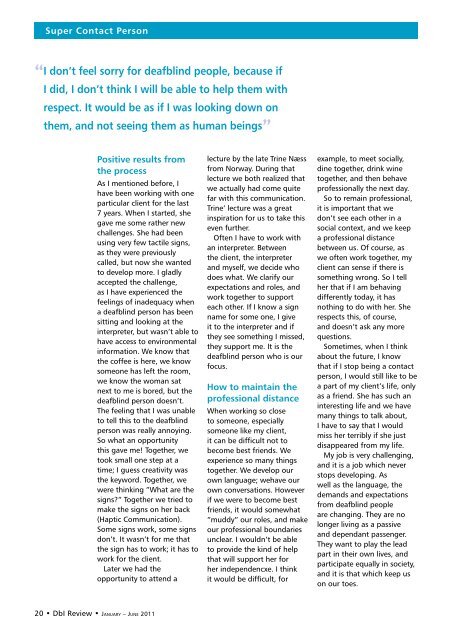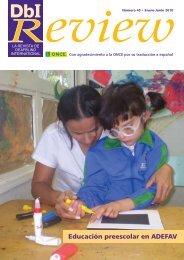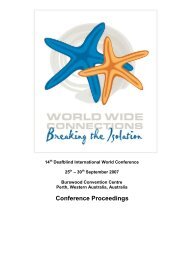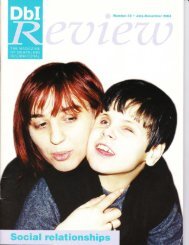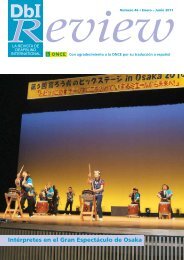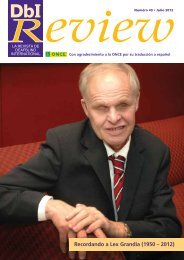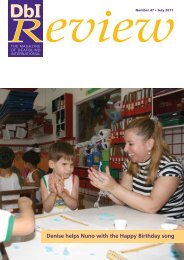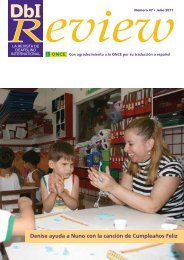Performers at Osaka's Big Stage - Deafblind International
Performers at Osaka's Big Stage - Deafblind International
Performers at Osaka's Big Stage - Deafblind International
You also want an ePaper? Increase the reach of your titles
YUMPU automatically turns print PDFs into web optimized ePapers that Google loves.
Super Contact Person“ I don’t feel sorry for deafblind people, because ifI did, I don’t think I will be able to help them withrespect. It would be as if I was looking down onthem, and not seeing them as human beings ”Positive results fromthe processAs I mentioned before, Ihave been working with oneparticular client for the last7 years. When I started, shegave me some r<strong>at</strong>her newchallenges. She had beenusing very few tactile signs,as they were previouslycalled, but now she wantedto develop more. I gladlyaccepted the challenge,as I have experienced thefeelings of inadequacy whena deafblind person has beensitting and looking <strong>at</strong> theinterpreter, but wasn’t able tohave access to environmentalinform<strong>at</strong>ion. We know th<strong>at</strong>the coffee is here, we knowsomeone has left the room,we know the woman s<strong>at</strong>next to me is bored, but thedeafblind person doesn’t.The feeling th<strong>at</strong> I was unableto tell this to the deafblindperson was really annoying.So wh<strong>at</strong> an opportunitythis gave me! Together, wetook small one step <strong>at</strong> <strong>at</strong>ime; I guess cre<strong>at</strong>ivity wasthe keyword. Together, wewere thinking ”Wh<strong>at</strong> are thesigns?” Together we tried tomake the signs on her back(Haptic Communic<strong>at</strong>ion).Some signs work, some signsdon’t. It wasn’t for me th<strong>at</strong>the sign has to work; it has towork for the client.L<strong>at</strong>er we had theopportunity to <strong>at</strong>tend alecture by the l<strong>at</strong>e Trine Næssfrom Norway. During th<strong>at</strong>lecture we both realized th<strong>at</strong>we actually had come quitefar with this communic<strong>at</strong>ion.Trine’ lecture was a gre<strong>at</strong>inspir<strong>at</strong>ion for us to take thiseven further.Often I have to work withan interpreter. Betweenthe client, the interpreterand myself, we decide whodoes wh<strong>at</strong>. We clarify ourexpect<strong>at</strong>ions and roles, andwork together to supporteach other. If I know a signname for some one, I giveit to the interpreter and ifthey see something I missed,they support me. It is thedeafblind person who is ourfocus.How to maintain theprofessional distanceWhen working so closeto someone, especiallysomeone like my client,it can be difficult not tobecome best friends. Weexperience so many thingstogether. We develop ourown language; wehave ourown convers<strong>at</strong>ions. Howeverif we were to become bestfriends, it would somewh<strong>at</strong>“muddy” our roles, and makeour professional boundariesunclear. I wouldn’t be ableto provide the kind of helpth<strong>at</strong> will support her forher independencxe. I thinkit would be difficult, forexample, to meet socially,dine together, drink winetogether, and then behaveprofessionally the next day.So to remain professional,it is important th<strong>at</strong> wedon’t see each other in asocial context, and we keepa professional distancebetween us. Of course, aswe often work together, myclient can sense if there issomething wrong. So I tellher th<strong>at</strong> if I am behavingdifferently today, it hasnothing to do with her. Sherespects this, of course,and doesn’t ask any morequestions.Sometimes, when I thinkabout the future, I knowth<strong>at</strong> if I stop being a contactperson, I would still like to bea part of my client’s life, onlyas a friend. She has such aninteresting life and we havemany things to talk about,I have to say th<strong>at</strong> I wouldmiss her terribly if she justdisappeared from my life.My job is very challenging,and it is a job which neverstops developing. Aswell as the language, thedemands and expect<strong>at</strong>ionsfrom deafblind peopleare changing. They are nolonger living as a passiveand dependant passenger.They want to play the leadpart in their own lives, andparticip<strong>at</strong>e equally in society,and it is th<strong>at</strong> which keep uson our toes.20 • DbI Review • Jan u a r y – Ju n e 2011


